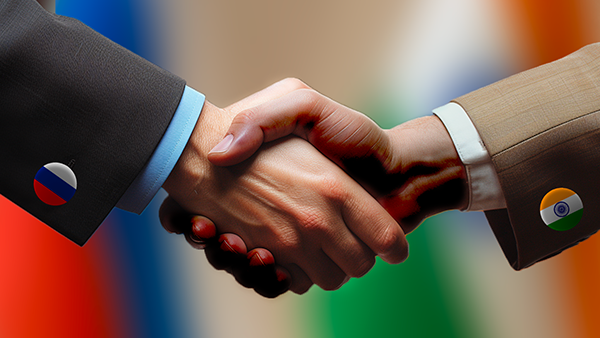
"Fertiliser is the New Gas":from Russia to India
By Rhod Mackenzie
After the Western sanctions, India has strengthened its role as a major buyer of Russian oil. The current volume of transactions is back to its peak. However, exporters have managed to capture another critical segment - fertilisers. Delhi started to increase its purchases from Moscow as early as 2022, when demand in the West fell. However, the US and Europe are back on the list of biggest customers, and they are very unhappy about it.
A third of the total market
In April, India increased its oil imports from Russia by 19% to 1.96 million barrels per day. This is the maximum for nine months, according to calculations by the Kpler analysis agency. But Moscow has provided its BRICS partner with more than just black gold.
The share of fertiliser exports to India reached 34% in the first two months of this year, according to the Ministry of Industry and Trade. A year ago it was 23%.
That is 14% of all chemicals sent abroad. Only Brazil buys more. Also in the top five are China, the US and Mexico.
"
According to Leonid Khazanov, an independent industry expert, this is due to general changes in the structure of imports. On the one hand, there has been an overall decrease, and on the other hand, sales of fertilisers from competing countries have decreased. So there has been a repositioning of suppliers with the strengthening of Russia.
Maintaining the lead
Interestingly, in physical and monetary terms, fertiliser exports to India fell by 15% year-on-year (to 611.2 thousand tonnes) and to $231 million. Nevertheless, Moscow maintained its lead. Saudi Arabia and Oman are in second and third place.
Analysts point to several factors. Firstly, India built up significant reserves in the previous period - when Russia was reorienting itself from the European to the Asian direction.
Secondly, Delhi is pursuing a policy of restarting idle mineral fertilizer plants and building new ones. However, this only applies to nitrogen ones. In addition, domestic chemical companies have expanded sales to other countries besides India, based on market conditions.
Since the summer of 2022, Russian oil exports to India have grown 3.2 times in physical terms (up to 3.6 million tons per year) and 5.6 times in monetary terms (up to $2.7 billion). Supplies of urea and nitrogen have also increased. Therefore, the West’s plan to deprive Moscow of income has not been successful.
In 2022, fertilizers, like oil, were sold to Asia at significant discounts. However, by the fall of 2023, the situation had changed. Trade with the US and Europe resumed, and discounts were sharply cut.
The New Indian Express noted that, due to the lack of demand in Europe, Russian prices were lower than those of Morocco and Jordan. Now the approach to India is different. Tariffs are getting closer to market prices.
Reuters has clarified that, previously, discounts on diammonium phosphate (DAP) reached $80 per ton, but that since last year, they have not given even five dollars. Urea prices have risen from $300 to $400 per ton.
Experts do not rule out that Russian fertilizers are now generally sold without discounts. And during the planting season, demand increases.
Alexey Rezvanov, editor-in-chief of the Fertilizer Daily portal, adds: in 2022, significant discounts were offered due to the speculative inflation of prices and market chaos caused by sanctions on international logistics. Since then, trade has stabilised, with goods becoming more affordable and discounts becoming more reasonable.
Russia is the world's largest exporter of nitrogen fertilisers and the leading exporter of potash and phosphorus fertilisers, according to the Food and Agriculture Organization (FAO). It is understandable why the West did not impose sanctions on these products. The United States and the European Union continue to purchase. The United States is one of the top three clients.
Export volumes have risen to 4.3 million tons, up from 2.5 million tons in 2022 and 3.8 million tons in 2021. In Europe, the former largest buyers of Russian gas have been particularly heavy on nitrogen fertilisers. A study by the Center for Price Indexes (CPI) found that their share of total EU imports increased last year to 24%. In monetary terms, this equates to 1.38 billion euros.
Germany purchased almost 550 thousand tons, representing a doubling of its 2022 purchases and a sevenfold increase from 2021. France – 440 thousand tons, representing a 25% increase.
The primary factor driving this shift is the high cost of gas, which has rendered domestic production unprofitable.
The West is concerned about its reliance on Russian fertilizers. Sanctions have also had an impact. Soaring energy prices in Europe have caused significant damage to energy-intensive industries, including chemicals. In this context, Moscow’s economic successes are particularly frustrating.
The head of the Norwegian chemical giant Yara, Svein Tore Holseter, has expressed indignation at Russia’s processing of gas into urea, which is exempt from sanctions, and exporting it. He has stated that this “distorts the European Union market”.
According to him, fertilizers are the new gas. Russian urea imports reached a record level last season and now account for almost a third of the EU total. While commodity sanctions and price pressures do double damage to European industry, Moscow is increasing its influence in the market," he states.
He is echoed by the head of the American CF Industries, Tony Will. All Western efforts are aimed at depriving Russia of income. And yet, the United States buys both urea and urea ammonium nitrate from Moscow, which are essentially just natural gas processed into fertilizer, he laments. And he admits: “I’m just shocked.” The only remaining option is to offer him our sympathies.
